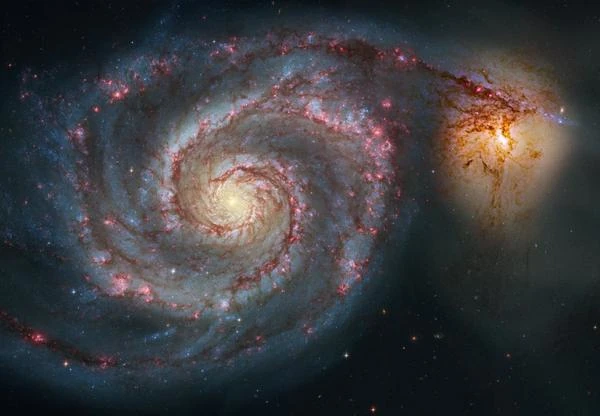
Image description: The future collision between the Milky Way and the Sagittarius galaxy could resemble the Whirlpool galaxy absorbing NGC 5195, its companion to the right of the image. Image source: NASA.
The Sagittarius galaxy was discovered in 1994 by a team of astronomers (Rodrigo Ibata, Michael Irwin, and Gerard Gilmore). The Sagittarius dwarf galaxy has a diameter of 10,000 light-years and contains approximately 200 million stars. The Milky Way has a diameter of 100,000 light-years and contains approximately 200 billion stars. The Sagittarius galaxy is located about 70,000 light-years from Earth, traveling on a nearly polar orbit (an orbit passing over the galactic poles of the Milky Way) at a distance of about 50,000 light-years from the center of the Milky Way.
The orbit of the Sagittarius galaxy is highly inclined, with an angle of 60 to 90 degrees relative to the galactic plane. This means it moves not only above and below the galactic plane but also through regions of high inclination relative to this plane. The trajectory of this galaxy around the Milky Way's core is highly elliptical, causing it to pass close to the galactic center at times and then move farther out to the periphery.
This polar orbit causes the Sagittarius galaxy to traverse the galactic halo, where it is influenced by the Milky Way's gravity, contributing to its accretion process and the eventual partial dissolution of the Sagittarius galaxy. Due to this trajectory, Sagittarius is in constant gravitational interaction with the Milky Way, leading to effects such as the stripping of its stars and gas through gravitational tides, thus contributing to its slow destruction.
The Sagittarius galaxy began merging with our galaxy about 4 to 5 billion years ago. This merging process is a major cosmic event that unfolds over billions of years. The collision between the Milky Way and the Sagittarius galaxy is an example of galactic cannibalism, where a larger galaxy slowly absorbs a smaller one.
The stars of the Sagittarius galaxy are gradually being integrated into the Milky Way, enriching our galaxy with new stars and interstellar matter.
The collision with the Sagittarius galaxy will have several impacts on the Milky Way. In addition to stimulating the formation of new stars in our galaxy, this merger could disrupt the orbits of existing stars, altering the structure of the Milky Way.
However, it is important to note that stars are so far apart that direct collisions between stars are extremely rare. Most stars from the Sagittarius galaxy will simply be integrated into the Milky Way without colliding with other stars.
Waves of matter, known as "density waves" or "tidal waves," will propagate through our Galaxy and contribute to the formation of spiral arms. These waves are perturbations in the distribution of matter (stars, gas, and dust) that propagate through the galaxy in response to the gravitational forces exerted by the merging galaxy.
Although the merger of the Sagittarius galaxy with the Milky Way is a major event, it will likely have no direct impact on our solar system. The Sun and the planets will continue their orbit without being significantly disrupted by this collision.
Our solar system is currently located in a region of the Milky Way known as the "Local Bubble." This bubble is a relatively empty cavity of interstellar matter, composed of hot (about one million degrees Kelvin) and rarefied gas. This region contrasts with the denser and cooler molecular clouds that exist elsewhere in the galaxy. The Local Bubble was created by supernova explosions about 10 to 20 million years ago, which swept away interstellar gas and dust, leaving behind a low-density region. Our solar system is located near the edge of the Local Bubble. Observations suggest that we entered this bubble about 5 to 10 million years ago and could remain sheltered in this region for several more million years.
Galaxies form from the aggregation of matter in the early universe. Over time, small galaxies merge to form larger ones. Most large galaxies, including our own Milky Way, are the result of mergers with smaller galaxies throughout their history. Galactic mergers play a crucial role in the evolution of galaxies and are a common process in the universe.
The Milky Way has experienced a period of relative stability over the past few billion years. This means it has not undergone major mergers or significant disruptions that would have radically altered its overall structure. The stability of the Milky Way has allowed for relatively constant star formation and a well-defined galactic structure, with spiral arms and a central bulge.
The Andromeda galaxy has a more turbulent history. It has experienced major mergers with other galaxies, leading to a more complex structure and intense episodes of star formation. Andromeda likely merged with a significantly sized galaxy about 2 to 3 billion years ago, which disrupted its structure and led to the formation of new stars and galactic structures. Due to these mergers, Andromeda exhibits distinct characteristics, such as a more disturbed disk and more active star-forming regions.
The Sagittarius galaxy offers a unique opportunity to observe an ongoing galactic merger, allowing for the testing of theoretical models and a better understanding of galactic dynamics.
Observations of the Sagittarius galaxy are conducted using ground-based and space-based telescopes, such as the Hubble Space Telescope and the Gaia Telescope. These observations help map the distribution of stars and interstellar matter, as well as track the evolution of the merger.